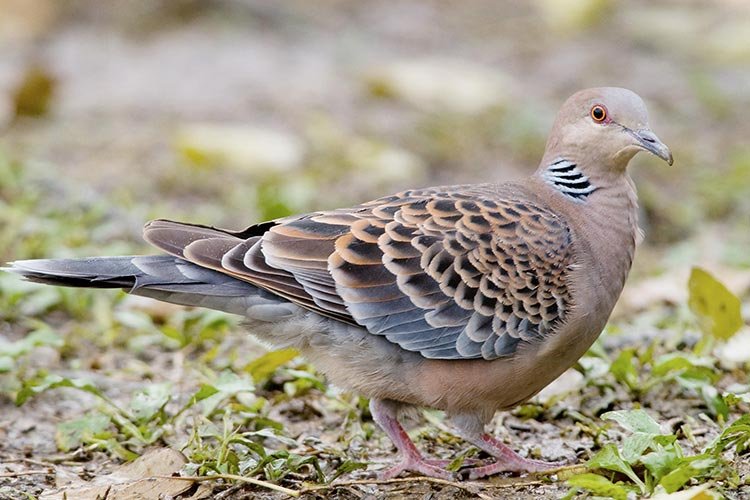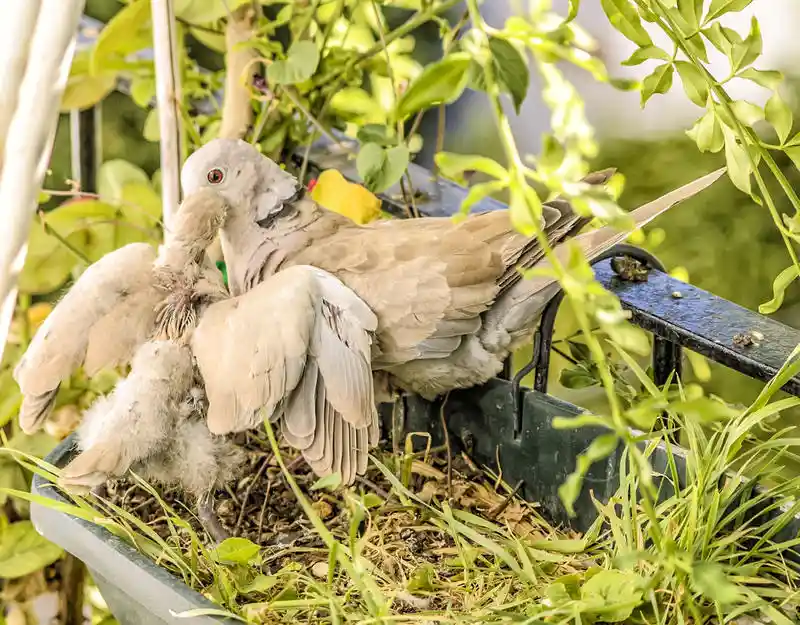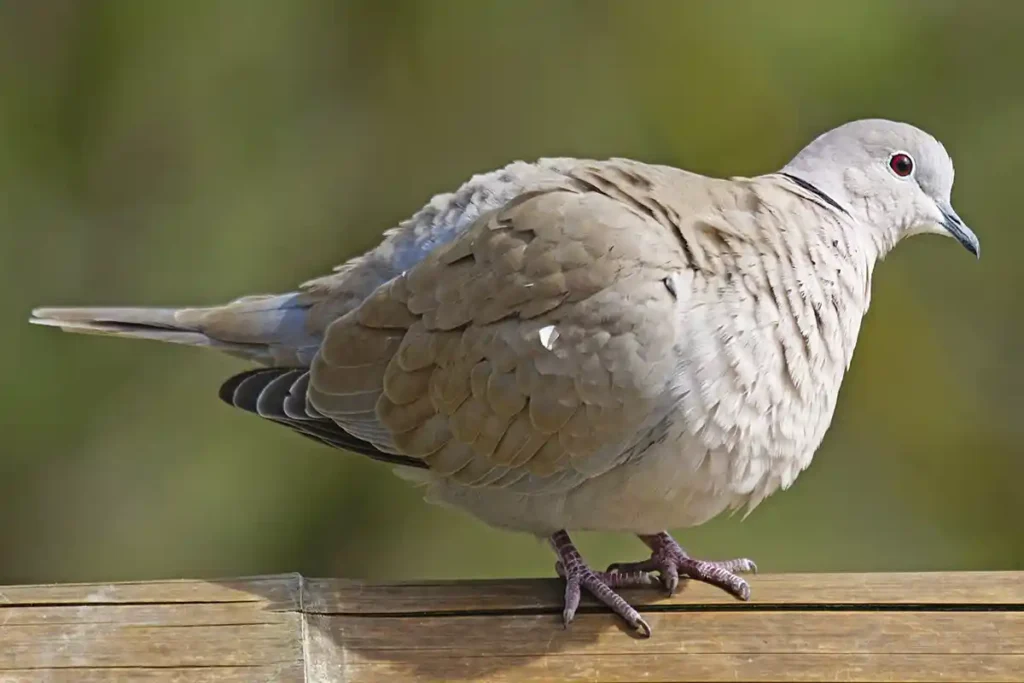
The turtledove is a migratory bird known for its slender body and distinctive call. Its scientific name is Streptopelia turtur, and it is recognized for its gracefulness and beauty in the wild. This bird inhabits various regions across Europe, North Africa, and parts of Asia. However, it faces significant threats that have impacted its population. Conservation efforts are crucial to ensure the survival of the turtledove and its habitats.
Turtledove characteristics
This bird exhibits distinct physical traits, a unique vocalization, and a graceful flight style. These characteristics play a significant role in its identification and behavior in the wild.
Physical description
The turtledove is characterized by its slender build and elegant appearance, and their smaller than pigeons. It typically measures between 26 and 28 cm in length and weighs between 100 and 156 grams. The plumage is primarily a soft brown color, providing effective camouflage in its natural environment.
- Coloration: Adults feature a more vibrant coloration with a distinctive black and white patch on the side of their neck. This marking is one of the key identifiers of the species. Juveniles, in contrast, display a more muted, less colorful plumage, which gradually becomes more pronounced as they mature.
- Tail structure: The tail of the turtledove is uniquely shaped like a wedge, exhibiting a dark center flanked by white edges. This structural aspect contributes to its overall aerodynamics during flight.
Distinctive Call
The turtledove possesses a characteristic call that is often described as a soft ‘turrr, turrr’ sound. This call is not only vital for communication but also plays an integral role during mating rituals. The melodic quality of the call makes it easily recognizable, allowing both mates and other birds to identify one another.
Flight pattern
The flight of the turtledove is marked by elegance and precision. Its flight pattern is generally direct, although not particularly rapid. This ability allows them to navigate effectively through open landscapes.
- Speed and style: during flight, the bird flaps its wings in a rhythmic, steady manner, which reflects its calm and graceful nature. The flight is often characterized by short bursts of speed followed by gliding, making it a beautiful sight in flight.
- Behavior in group: when in flocks, turtledoves can appear quite social, displaying coordinated movements and fluid transitions. This behavior highlights their strong social connections, particularly during migration.

Habitat and distribution
The turtledove can be found across a variety of landscapes. Its habitat preferences and migratory behaviors are essential to understanding its survival and conservation needs.
Turtledoves thrive in semi-open areas where they can find adequate food and nesting sites. Their favored environments include:
- Agricultural fields
- Woodland edges
- Hedgerows
- Orchards and gardens
These habitats provide a rich supply of seeds from wild plants and crops, which compose a substantial part of their diet.
Migration Patterns
The turtledove exhibits a remarkable migratory pattern, moving between breeding and wintering grounds annually. This migration is primarily influenced by seasonal changes and food availability.
During the breeding season, which typically starts in late spring, turtledoves migrate to their nesting territories located across southern and western Europe. Preferred breeding areas usually consist of open landscapes with a mix of farmland and natural vegetation, enabling easy access to food sources and safe nesting sites.
As the colder months approach, turtledoves migrate southward to wintering grounds in North Africa. Countries such as Morocco and Tunisia serve as major wintering habitats. Here, they find mild climates and abundant food resources, allowing them to sustain their populations until spring encourages their return to breeding areas.
Threats and conservation efforts
This bird faces multiple challenges that threaten its survival. Conservation efforts are underway to address these issues and restore populations. Understanding the specific threats and active measures is crucial for the preservation of this vulnerable species.
Modern agricultural methods have significantly impacted the availability of food sources for the turtledove. The intensive use of fertilizers and pesticides has led to a decline in the abundance of wild plant seeds, a major part of their diet. Changes in farming practices, such as increased monoculture, have also reduced the diversity of habitats needed for nesting and feeding.
Hunting remains a severe threat to turtledove populations, particularly during migration seasons. Illegal hunting practices, particularly in Mediterranean countries, have resulted in millions of turtledoves hunted each year. This unsustainable harvesting puts enormous pressure on already dwindling numbers, complicating conservation efforts.
Habitat Loss
Urban development and agricultural expansion have led to significant habitat loss for the turtledove. The destruction of natural environments, including forests and hedgerows, has eliminated critical nesting sites and foraging areas. As these habitats disappear, the turtledove struggles to find safe locations for breeding and nourishment.
Disease (Trichomonosis)
Trichomonosis, a parasitic disease, poses an additional threat to Streptopelia turtur populations. This disease can cause severe health issues, impacting the birds’ ability to feed and reproduce. Outbreaks of this illness can lead to high mortality rates, further exacerbating the decline of local populations.
Conservation programs
Efforts to conserve the turtledove include a variety of dedicated programs aimed at reversing the decline of its population. These initiatives focus on habitat restoration, legal protections, and public awareness campaigns.
Several countries have implemented laws to protect turtledoves from hunting and poaching. By establishing closed seasons and designated protected areas, these regulations aim to mitigate the impact of human activities on their populations.
Operation Turtle Dove
Operation Turtle Dove is a multi-faceted conservation program designed to monitor and support the species across its range. This initiative prioritizes habitat management and research to understand better the factors contributing to population decline.
Supplementary feeding
Supplementary feeding programs have been introduced in some regions to help boost turtledove numbers. By providing reliable food sources during critical times, these efforts aim to support both adult birds and their young, enhancing survival rates in challenging environments.
Role of volunteers
Volunteers play a vital role in conservation efforts for this bird. Many local organizations depend on community involvement to conduct monitoring, habitat restoration, and awareness-raising activities. Engaging volunteers not only helps gather crucial data but also fosters a deeper connection between communities and their natural environments.

How to help turtledoves
Conservation efforts for turtledoves require collective action from individuals and communities. Several initiatives can contribute significantly to the survival of this majestic bird.
Creating suitable habitats is essential to provide food and refuge for turtledoves. This can be achieved through the following actions:
- Planting native flora that attracts insects and provides seeds.
- Maintaining hedgerows and wooded areas that serve as safe nesting sites.
- Implementing sustainable gardening practices to foster a healthy ecosystem.
Documenting sightings of turtledoves plays a crucial role in monitoring their populations. Reports can help researchers track migration patterns and evaluate habitat use. Individuals can contribute by:
- Using citizen science platforms to log sightings.
- Keeping detailed records of locations and dates.
- Sharing information with local wildlife organizations to assist ongoing studies.
Engaging in community initiatives can enhance conservation measures. Local programs may include:
- Organizing cleanup events to remove litter from habitats.
- Participating in educational workshops to raise awareness about turtledoves and their ecological importance.
- Collaborating with conservation groups on habitat restoration projects.
Financial contributions are vital for organizations dedicated to their conservation. The following methods can bolster these efforts:
- Making one-time or recurring donations to wildlife charities focused on avian species.
- Supporting fundraising events that promote awareness and conservation strategies.
- Providing resources for research and educational outreach.
